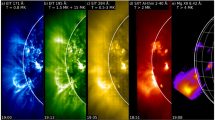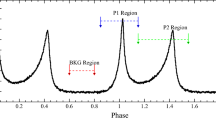Abstract
The betatron mechanism was proposed by Brown and Hoyng (1975) as a means of producing the continuous, quasi-periodic electron acceleration which may occur in long-lasting hard X-ray events. In the present work, two pertinent facets of the betatron model are investigated: The possibility that the multiplicity characteristic of complex impulsive bursts is due to the betatron process; and the possibility that some or all of the second-stage emission during two-stage bursts can be attributed to betatron acceleration. To test for the pattern of X-ray spectral behavior predicted by the betatron model, a number of multiply-impulsive events (cf., Karpen et al., 1979) and two-stage bursts (cf., Frost and Dennis, 1971) were selected from the OSO-5 hard X-ray spectrometer data for in-depth analysis. The purely impulsive emissions show no signs of the effects of betatron action, thus eliminating this process as a potential source of impulsive-phase multiplicity. However, the spectral characteristics determined during the first few minutes of the second stage are found to be consistent with the predictions of the betatron model for the majority of the two-stage events studied. The betatron-acceleration mechanism thus is proposed as a common second-stage phenomenon, closely associated with the diverse phenomena at other wavelengths which characterize this phase of emission. The physical significance of the source parameters derived according to the model-fitting procedure are discussed in detail, and the role of the betatron process is evaluated in the broader context of present-day concepts of the second stage.
Similar content being viewed by others
References
Benz, A.: 1977, Astrophys. J. 211, 270.
Brown, J. C.: 1971, Solar Phys. 18, 489.
Brown, J. C.: 1973, Solar Phys. 32, 227.
Brown, J. C. and Hoyng, P.: 1975, Astrophys. J. 200, 734.
Brown, J. C. and McClymont, A. N.: 1976, Solar Phys. 49, 329.
Crannell, C. J., Frost, K. J., Mätzler, C. M., Ohki, K., and Saba, J. L.: 1978, Astrophys. J. 223, 620.
Frost, K. J.: 1969, Astrophys. J. Letters 158, L159.
Frost, K. J. and Dennis, B. R.: 1971, Astrophys. J. 165, 655.
Harvey, K. L., Martin, S. F., and Riddle, A. C.: 1974, Solar Phys. 36, 151.
Hoyng, P.: 1975, Ph.D. thesis, University of Utrecht.
Hoyng, P., Brown, J. C., and van Beek, H. F.: 1976, Solar Phys. 48, 197.
Karpen, J. T.: 1980, Ph.D. thesis, University of Maryland.
Karpen, J. T., Crannell, C. J., and Frost, K. J.: 1979, Astrophys. J. 234, 370.
Krall, N. A. and Trivelpiece, A. W.: 1973, Principles of Plasma Physics, McGraw-Hill, New York.
Kundu, M. R.: 1965, Solar Radio Astronomy, Interscience, New York.
Lipa, B.: 1978, Solar Phys. 57, 191.
Maxwell, A. and Fitzwilliam, J.: 1973, Astrophys. Letters 13, 237.
McLean, D. J., Sheridan, K. V., Stewart, R. T., and Wild, J. P.: 1971, Nature 234, 140.
Parks, G. K. and Winckler, J. R.: 1969, Astrophys. J. Letters 155, L117.
Riddle, A. C.: 1970, Solar Phys. 13, 448.
Robinson, R. D.: 1978, Solar Phys. 60, 383.
Schmahl, E. J.: 1973, Australian J. Phys. Suppl. 29, S28.
Smerd, S. F. and Dulk, G. A.: 1971, in R. Howard (ed.), ‘Solar Magnetic Fields’, IAU Symp. 43, 616.
Solar-Geophysical Data: 1969 March–1972 February, Nos. 296–330, Boulder, Colo., U.S. Department of Commerce, NOAA.
Stewart, R. T. and Sheridan, K. V.: 1970, Solar Phys. 12, 229.
Wild, J. P. and Smerd, S. F.: 1972, Ann. Rev. Astron. Astrophys. 10, 159.
Author information
Authors and Affiliations
Rights and permissions
About this article
Cite this article
Karpen, J.T. The role of betatron acceleration in complex solar bursts. Sol Phys 77, 205–230 (1982). https://doi.org/10.1007/BF00156105
Received:
Revised:
Issue Date:
DOI: https://doi.org/10.1007/BF00156105




